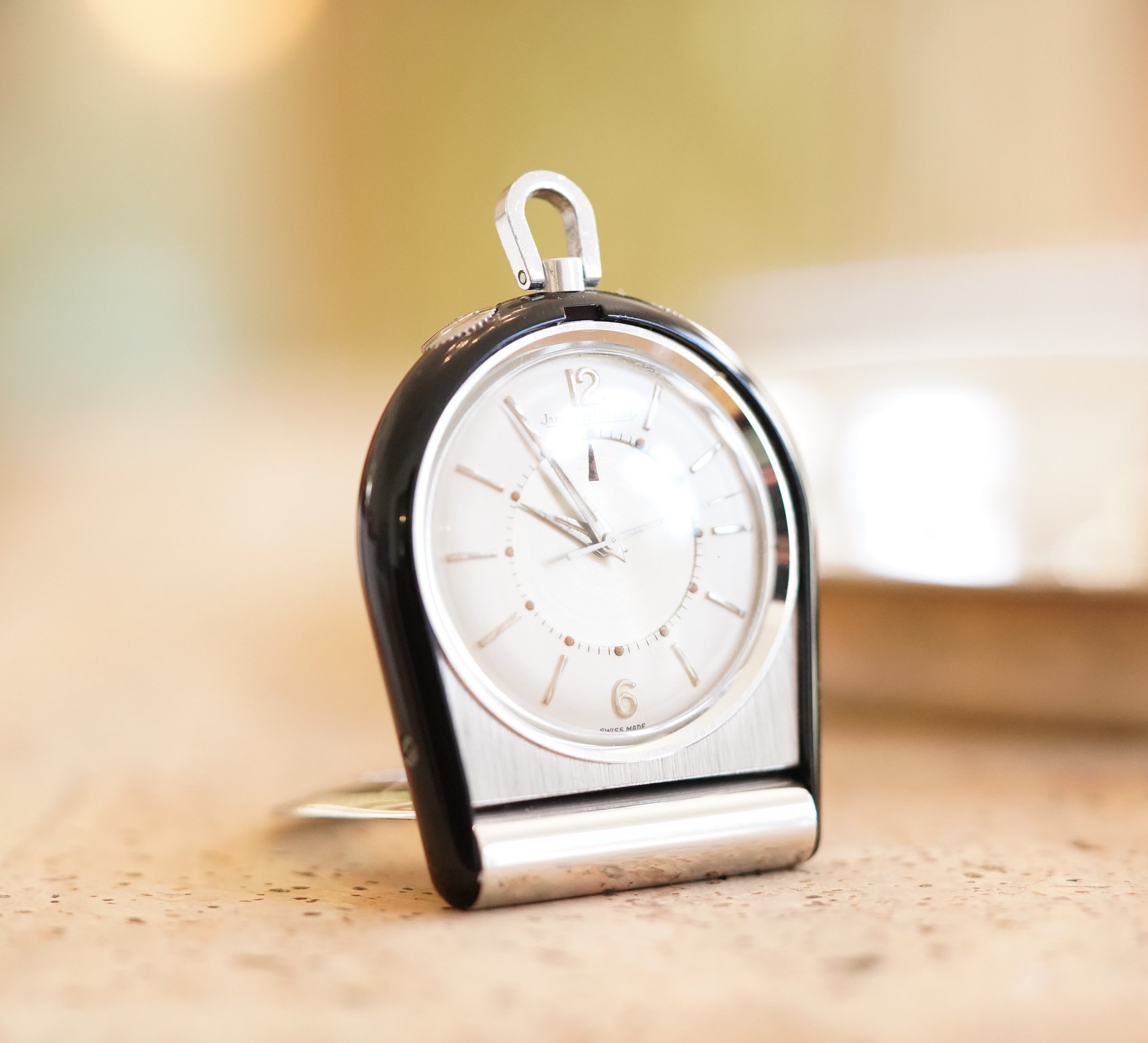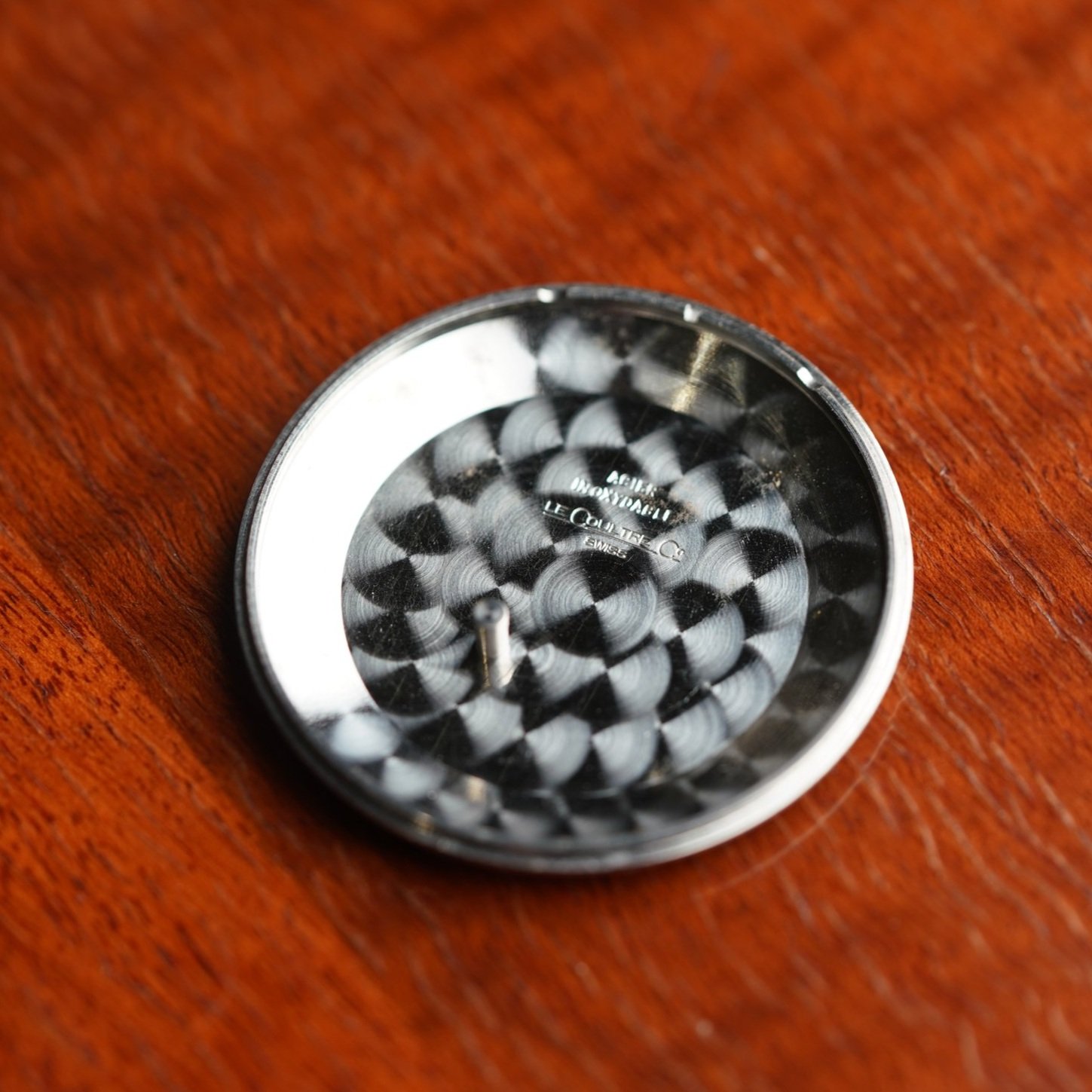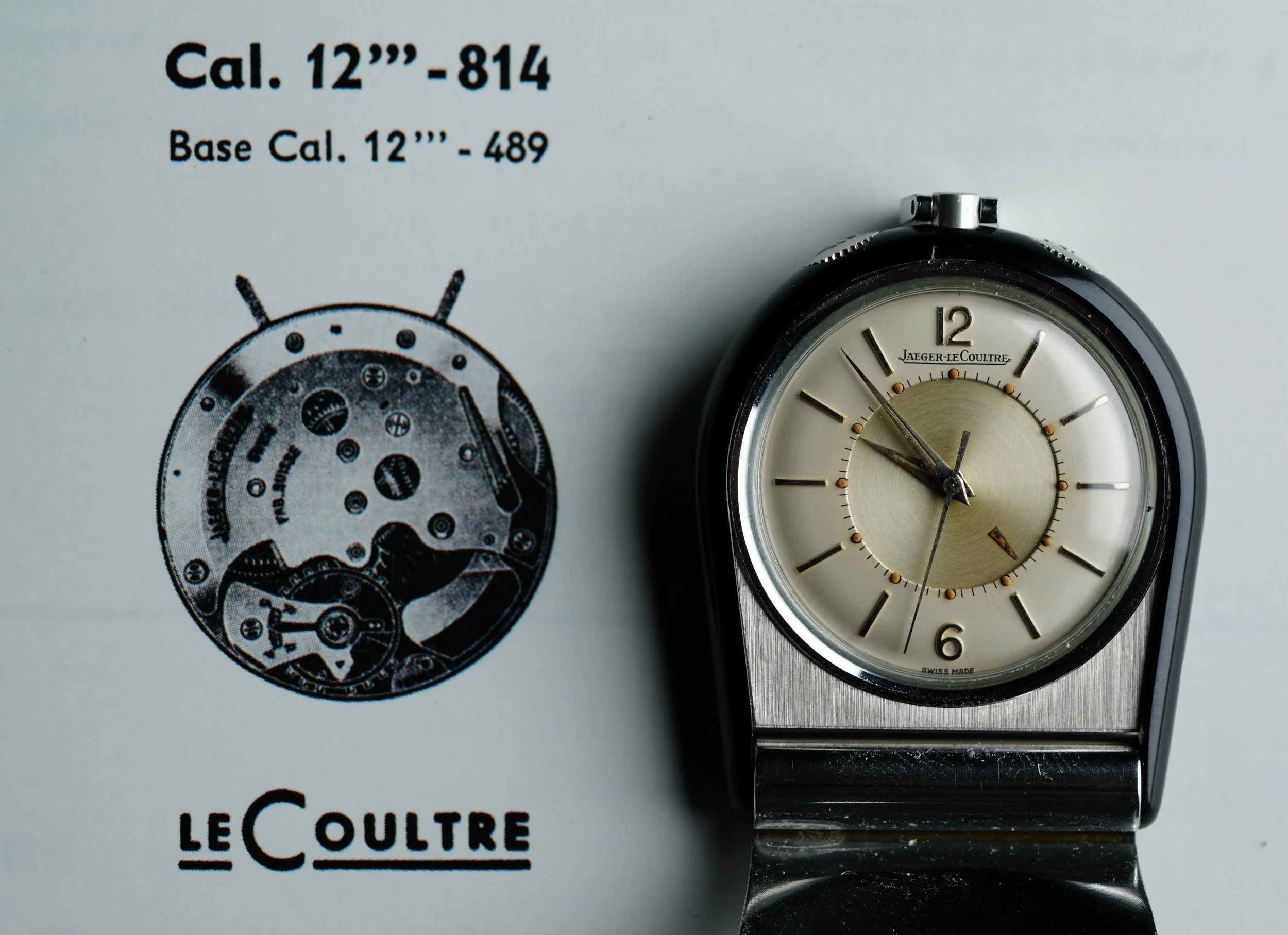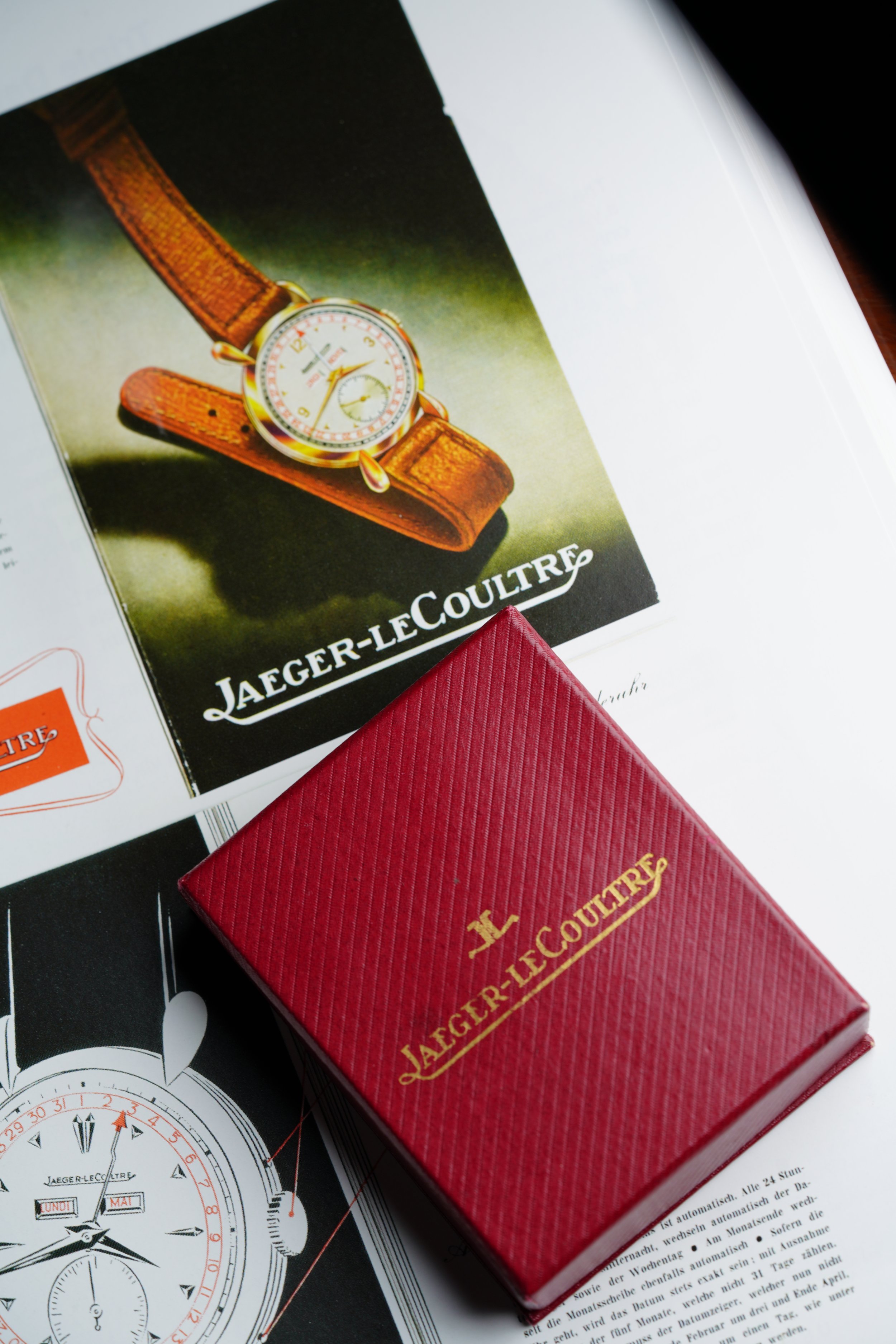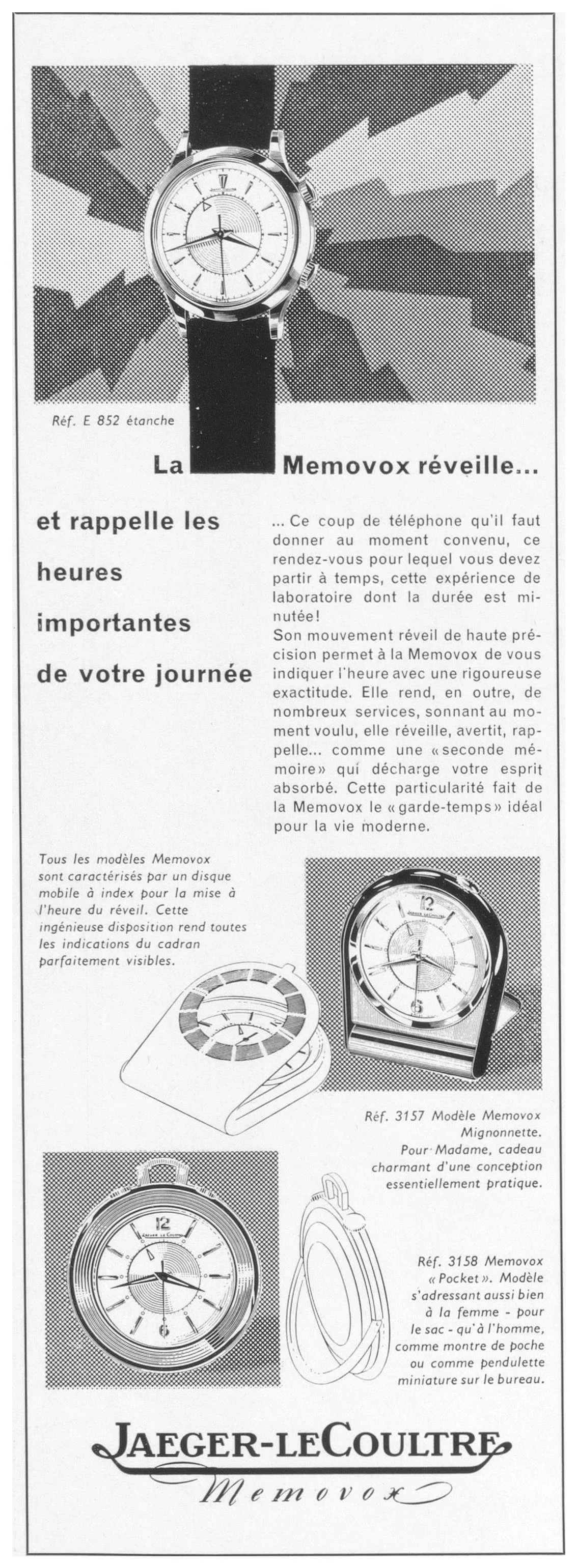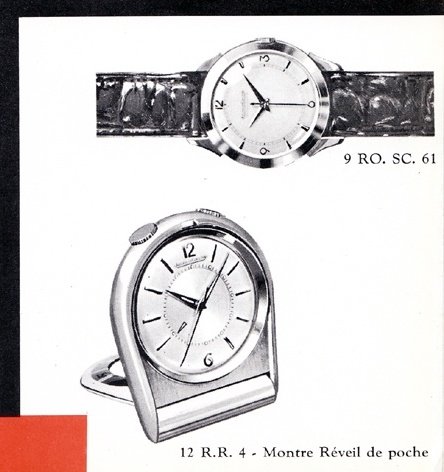
Vintage Jaeger-LeCoultre Memovox "Mignonnette" Reference 3157 aka the “Travalarm”
By Charlie Dunne
A few weeks back I explored the vintage LeCoultre 8 Day alarm travel clock reference 53, and at the time I had no idea I would be adding another alarm to the collection. While the brass reference 53 was a seriously cool come-up, the news of a chrome-plated pocket watch was music to my ears.
The Dial
Breaking from the theme of applied 3, 6, 9, and 12 applied numerals within my LeCoultre lineup, this Memovox maintains only the 6 and 12. The remaining feature applied baton markers. The luminous plots on the edge of the external are retained and quite puffy. The central rotating disc has a concentric brush with a luminous isosceles triangle as opposed to the more common equilateral triangle.

The Case
The hinged exterior is made of chrome and the case body features stainless steel. It stands 43mm tall and measures 37mm at its widest point. The width is 11mm. The case body features a vertically brushed surface on both sides, while the hinged cover, bezel, and portion of the caseback maintain a smooth, mirror finish.
The Movement
Powered by the calibre K814, the movement is a very common manual wound alarm movement from the Le Sentier manufacturer which is found in both pocket watches and wristwatches (such as the reference 2404). The K814 indicates the calibre incorporated the shock protection via KIF. The producer of the technology is Parechoc S.A. (also based in Le Sentier at the time of the timepiece’s production). Judging soley off the appearance, it appears to incorporate the KIF A shock absorber. Key benefits of the KIF A include high durability, simple removal, and re-assembly, as well as interchangeability across ebauche movements.
KIF A advertisement featured in the article ‘Portescap KIF Vintage Ads’ by Stephen Foskett (Grail-Watch.com).
The watch is not found within books on the brand, nor in those focused on the category of alarm watches. Hovever Leonhard Beitl’s compendium ‘Alarm am Arm. Der mechanische Armbandwecker von A-Z’, a Jaeger-LeCoultre catalogue from the 1970s features a similar travel alarm. Presented on the same page as a Polaris II Red E870 and Memovox Snowdrop Speedbeat reference E877 is a model designated as a reference 11076. While the case is also chrome, the difference can be seen in the luminous stick hands. The overall DNA is similar, except it is a calendar model. A variation of the model can be seen in the gilt reference 11074.
The Box
The alarm pocket watch accompanies a red presentation box with a small black leather pouch. The interior of the leather has the brand’s signature. Unfortunately, no markings or maker’s initials are found to identify the producer of the presentation box..
Advertisements
Several months back I expressed an interest to Eric Wind that I had a desire to collect Jaeger-LeCoultre watches in a more serious manner (particularly those within their alarm line). After locating an advertisement which featured the reference 53 Eight-Day Alarm Clock, Wind had alluded to a follow-up timepiece for me to take a look at. It turned out he had sourced a second alarm model from the very same ad! Emphasizing it would be a great addition to my collection, I had little choice but to agree.
Yet there was still information I was eager to know. “What reference number was it? How many variations are there? Is there a specific time frame these were produced? How - and to whom - were these alarm watches marketed?” While some of the basics were fairly straightforward, more interesting details were yet to be discovered.
Jaeger-LeCoultre advertisement from1957 featuring the Memovox Pocket Alarm Watch as well as the reference 53 Eight-Day Alarm Clock.
Jaeger-LeCoultre advertisement circa 1957 featuring the reference E 852
During a previous correspondence with a European collector, I was informed that advertisements (such as the one below) featured numbers which were “French references”. The codes typically appear to correspond with the movement size (ligne) in some capacity. Yet, they didn’t serve to identify what the more universally used reference numbers were. Within the same thread, I noticed a second ad featuring the pocket alarm watch, but no concrete details on the reference. I was uninterested in settling for the advertisements I had seen published on the internet and sought out others.
Reference 3157 aka “Travalarm”
The first insight came by way of interesting terminology discovered within a full-page ad circulating in American newspapers in 1957. Located adjacent to the iconic Atmos clock is the small travel clock described as the “Travalarm”. It features the same dauphine hands and elongated alarm isosceles triangle on the central rotating disk. If you look closely, it also encompasses the black ring that conceals the majority of the dial upon being enclosed.
Within the text, the watchmaker emphasizes that “a small clock of heirloom perfection can cost as little as $25 [while others can be upwards of] $10,000”! Funnily enough, the perpetual calendar pocket watch featured within the same advertisement cited as “The Most Complicated Watch in The World” is priced at $14,000. Perhaps the $10,000 claim was not including pocket watches or wristwatches. With that in mind, I may find myself hunting old ad copy for an insanely priced clock throughout the 1950s.
Originally retailed at $75, the Memovox pocket alarm wasn’t a cheap horological accessory. Comparatively, the much larger LeCoultre Obelisk (“Obelisque”) clock was only $39.95. As for a “wrist alarm”, one could have expected to pay in the ballpark of $110 - $150 during the late 1950s.
Moving into the early 1960s, a similar LeCoultre pocket alarm came up within a Kansas City retailer’s holiday advertisements. Diamant’s Watches for Christmas included a few interesting watches such as a Wittnauer chronograph, as well as an asymmetrical Hamilton Electric designed by Richard Airbib.
However the Travalarm was different in that it featured a textured hood, and what appeared to be hour markers (likely painted) in a 3, 6, 9, and 12 layout. The watch has a slight premium on it three years later at a whopping $79.50.
Diamant’s advertisement featuring a LeCoultre Memovox Pocket Alarm Watch. Image credit: The Kansas City Star December 2, 1960.
Soon after searching into Swiss advertisements, a Türler advertisement featuring the same Travalarm stood out. The advertisement features an assortment of Jaeger-LeCoultre timepieces, as well as a fantastic Audemars Piguet coin watch. Although after noticing the corresponding number, I was not convinced that it was the reference number. The APs and JLC appear to be numbered alongside each other as if these were the product codes for the retailer. Nevertheless, it was an exciting addition to the current list of marketing material.
Türler advertisement featuring Jaeger-LeCoultre Memovox Pocket Watch or “Travalarm”. Image credit: Der Bund, Volume 107 (November 20, 1956)
While learning the American market’s terminology was a success, ultimately finding the reference number the new priority. After searching further into the Swiss newspaper database, I was able to locate primary source material in the form of a 1956 ad published in Der Bund, Volume 107.
Within the ad, several timepieces from the golden era of JLC appeared. The likes of a Memovox reference 852 and reference 3158 pocket watch alarm accompanied the “Travalarm” timepiece designated as reference 3157. Quite notable is the difference in prices for the American market and Swiss market being marked as CHF 195. Perhaps this has to do with the higher production costs in Switzerland, or that the movements were imported to be assembled by US workers.
The caption of the reference 3157 mentions the Miniature Memovox being “an ideal gift for all occasions” and that it is “especially appreciated by ladies.”
Jaeger-LeCoultre advertisement featuring Memovox Pocket Watch reference 3157 or “Travalarm”. Image credit: Der Bund, Volume 107, Number 522, 7 November 1956
After locating the initial Türler advertisement, it was quite clear that the marketing of the reference 3157 likely began as early as 1956 and in the United States in the following year. It turns out that these timepieces may have been quite popular for the retailer to promote, as it would reappear in the publication Die Tat during the 1959 Christmas season.
While today it is perhaps more suitable on a desk, at the time the watch was suited “for the lady's handbag and the gentleman's waistcoat pocket”.
Türler advertisement featuring Jaeger-LeCoultre Memovox Pocket Watch or “Travalarm”. Image credit: Image credit: Die Tat, 2 December 1959
1962 Jaeger-LeCoultre Watch Company Geneva Switzerland 1962 Swiss Ad Suisse Advert Horlogerie. Image credit: Ecrater.
Türler advertisement. Image credit: Die Tat, December, 15 1962
Searching into the 60s, one last advertisement was found, again from Türler, which featured the reference 3157. The retail price for the model was CHF 225 and it is promoted alongside a reference E855. In the background, a gentleman is shown busily attending to a phone call.
Türler advertisement featuring Jaeger-LeCoultre Memovox Pocket Watch or “Travalarm”. Image Credit: Neue Zürcher Nachrichten, Number 132, 8 June 1963 Edition 03.
The style of timepiece seems to have been spoken about with great acclaim within some newspaper articles in the U.S., one particular mention coming from the Lexington Herald-Leader in September of 1958. The article mentions that “Watchmakmakers of Switzerland have designed a pocket alarm watch for women as well as for men. It has a fob chain for pocket wear and converts to a bedside alarm for the traveler.” While no mention of Jaeger-LeCoultre is made, perhaps the reference to Watchmakers of Switzerland is intended to be a more familiar household name in the West during the 1950s. Interestingly, the article reflects many of the Swiss ad’s mentions of being ”perfect for career women”. It would be interesting to learn whether the marketing had played a role in who actually went about purchasing these timepieces, or if it may have just been an attempt to attract women clientele during the era.
Image credit: Lexington Herald-Leader (Sept. 23, 1958)
Alarm watches were often promoted as being ideal for the busy, working man (and women as we can see within the advertisements). Typically some reference is made to the individual as a being frequent traveler or on-the-road salesperson. In an era in which these travel watches are no longer necessary, it is quite fascinating to learn surprises on who the target demographic was.
The “Mignonnette” ref 3157 featured in A Vintage Jaeger-LeCoultre Memovox Catalog Circa 1958
To read about other Jaeger-LeCoultre timepieces, see below:
A Vintage Jaeger-LeCoultre Memovox Catalog Circa 1958
Collector’s Guide: Jaeger-LeCoultre Memovox Reference E 875
LeCoultre Chronograph Reference 224115
‘Vintage LeCoultre Memovox Reference 2404 (Circa 1960s)’
‘Vintage LeCoultre 8 Day Alarm Travel Clock Reference 53’
‘Jaeger-LeCoultre Reference 11016 A Clous de Paris alarm clock from Christmas of 1972’
Jaeger-LeCoultre Reference 11012 Retailed by Hermès
Jaeger-LeCoultre Memovox Reference E 851
LeCoultre Memodate: A Vintage Gold-Filled Gift For A 13 Year Old Collector
Watches Within A 1938 Men's Fashion Catalog
Photo Gallery Vintage Jaeger-LeCoultre Reference 2957‘
Parechoc and the P450/4C’: What is Parechoc, and what is it doing in my JLC?








